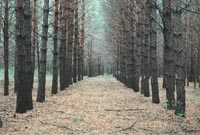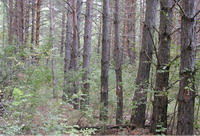Хемотаксономические особенности видов Armillaria
Kукина Т.П.1, Горбунова И.А.2 ,. Баяндина И.И3, Сальникова О.И.1
1Новосибирский институт органической химии СО РАН
630090 Новосибирск, проспект академика Лаврентьева, 9; е-mail: kukina@nioch.nsc.ru
2Центральный сибирский ботанический сад СО РАН
630090 Новосибирск, ул. Золотодолинская, 101; е-mail: root@botgard.nsk.su
3Новосибирский Государственный Агроуниверситет
Новосибирск
Фитохимическое исследование экстрактов плодовых тел дереворазрушающего гриба опенка осеннегоArmillariamellea(Vahl ex. Fr.) P. Kumm.привело к выделению и идентификации ряда биологически активных веществ, таких как жирные кислоты, терпеноиды, стерины, полипренолы, долихолы, пигменты и другие соединения. В Китае опенок осенний используется в пищу, а также для лечения головокружения, головной боли, неврастении, бессонницы и судорог. Тем не менее, сведения о химическом составе экстрактов опенка серого Armillaria cepistipes Velen в литературе отсутствуют.
Мы приготовили экстракт опенка серого и разделили его для исследования на кислые и нейтральные фракции. Наши условия анализа позволили идентифицировать ряд веществ, таких как алифатические кислоты, спирты и углеводороды, а также ди- и тритерпеновые соединения. Селективно выделен эритритол. Большинство БАВ обнаружено в исследованном сырье впервые. Полученные данные отличаются от компонентов экстрактовArmillariamellea.
Ключевые слова: хромато-масс-спектрометрия, липофильные компоненты, опенок осенний, Armillaria
Phytochemical investigation of extracts of fruiting bodies of the wood-rotting fungi honey mushroom Armillaria mellea (Vahl ex. Fr.) P. Kumm.led to the isolation and identification of several biologically active substantions, such as fatty acids, terpenoides, sterols, polyprenols, dolichols, pigments and other compounds. In China honey mushroom is eaten as food by people and used to treat of dizzness, headache, neurasthenia, insomnia, numbness in limbs, and convulsion. But information on the dominant components of extracts of Armillaria cepistipes Velen. is absent.
We obtainted MTBE-extract of fruiting bodies of Armillaria cepistipes and separated it towards neutral and acid constituents.
The neutral constituents were analyzed without the treatment (acetylation and silylation) using a Hewlett-Packard G 1800 A system with mass-selective detector HP 5971 and HP-5 MS column (30 m? 0,25 mm ? 0,25 ?m). The investigation of the acid fractions was carried out after full methylation by diazomethane on the same conditions.
Our conditions of analysis permit to identify a row of substances such as aliphatic acids, hydrocarbons and alcohols, and to investigate some di- and triterpenic compounds. Erythritol was obtained selective. The most of these biologically active substances were found for the first time in this raw material. The obtained data were different from constituents of Armillaria mellea extracts.
Key words: chromatomass-spectrometry, liophylic components, Armillaria, Honey Mushroom
БИБЛИОГРАФИЧЕСКИЙ СПИСОК
Кукина, Т.П. Полипренолы некоторых гомобазидиальных грибов (HOMOBASIDIOMYCETIDAE) / Т.П.Кукина, И.А.Горбунова, И.И.Баяндина // Химия растительного сырья. - 2007. - № 3. - С. 33-38.
Ayer, W.A. Metabolites of the honey mushroom, Armillaria mellea / W. A. Ayer, J. B. Macaulay // Can. J. Chem. – 1987. – Vol. 65, N 1. – P. 7–14.
Birkinshaw, J. H. Biochemistry of the wood-rotting fungi 5. The production of d-threitol (l-erythritol) by Armillaria mellea (Vahl) Quelet / J. H. Birkinshaw, C. E. Stickings, P. Tessier // Biochem J. – 1948. – Vol. 42, N 3. – P.329–332.
Ebrahimzadeh, H. Isolation and Characterization of Six Highly Intrinsic Fluorescent Metabolites in Armillaria mellea (Vahl. Ex. Fr.) Karst / H. Ebrahimzadeh, G.R. Haddadchi // Journal of sciences. Islamic republic of Iran. – 1995. – Vol.6, N 2. – P.67-79.
Guo, W.J. Triterpenes and steroids from Armillaria mellea Vahl. ex Fr./ W.J.Guo and other // Biochemical Systematic and Ecology – 2007. – Vol. 135, I. 11. – P. 790-793.
Guo, W.J. Steroids from Armillaria mellea / W.J.Guo, S.X. Guo // Химия природн. соедин. – 2008. - № 3. – С.322.
Lee, W.Y. Cytotoxic Activity of Ergosta-4,6,8(14),22-tetraen-3-one from the Sclerotia of Polyporus umbellatus / W.Y. Lee and other // Bull. Korean Chem. Soc. – 2005. - Vol. 26, N 9. – P. 1464-1466.
Obuchi, T. Armillaric acid, a new antibiotic produced by Armillaria mellea / T. Obuchi and other // Planta Med. – 1990. – Vol. 56, N 2. – P. 198-201.
Yang, J.S. Chemical constituents of Armillaria mellea mycelium. VII. Isolation and characterization of chemical constituents of the acetone extract / J.S.Yang and other // Yao Xue Xue Bao. – 1991. – Vol. 26, N 2. – P. 117-122.
Yilmaz, N. Fatty acid composition in some wild edible mushrooms growing in the middle Black Sea region of Turkey / N. Yilmaz and other // Food Chemistry. – 2006. – Vol. 99, I. 1. – P. 168-174.




